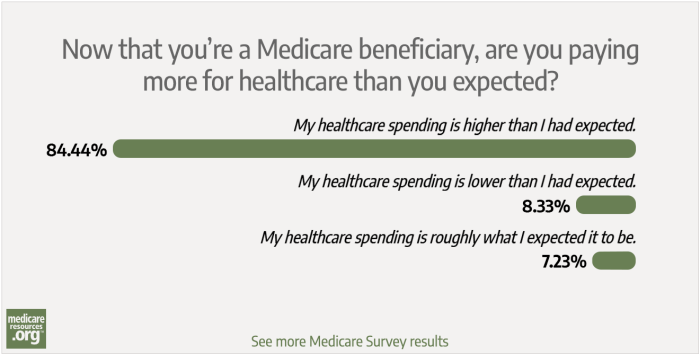While most people do not have to pay premium for Medicare Part A (if they or their spouse worked 10 years in Medicare-taxed employment), everyone is on the hook for Medicare Part B premiums. Add to that the cost of deductibles, copays, coinsurance, and even late penalties – and there are many out-of-pocket costs you will face when you are on Medicare.
Fortunately, when you know what costs to expect, you can find ways to minimize them and protect yourself.
How much do Medicare beneficiaries pay in out-of-pocket costs?
According to the Kaiser Family Foundation, the average Medicare household spent an average of $7,000 out of pocket on healthcare in 2022. This includes the cost of premiums.
To get a sense of how much you could pay, you have to first decide whether you want to enroll in Original Medicare (Medicare Part A and Medicare Part B) or Medicare Advantage (Medicare Part C).
Medicare Part A covers inpatient care as well as hospice care, skilled nursing facility care, and some home healthcare following an inpatient or skilled nursing facility stay. Medicare Part B covers physician services and outpatient care, covering expenses such as office visits, outpatient surgery, durable medical equipment, mental health care, certain vaccines, and certain medications that are administered in a medical office.
The former is traditional Medicare, run by the federal government, while the latter are managed care plans (e.g., HMOs and PPOs) run by private insurance companies.
Medicare Advantage plans are required to cover all of the medically necessary services that are covered by Original Medicare, but the out-of-pocket costs can differ. And Medicare Advantage plans can offer additional benefits that go beyond what Original Medicare offers. If you enrolled in Original Medicare, you can also sign up for a Medicare Part D prescription drug plan. Alternatively, you can pick a Medicare Advantage plan that also has Medicare Part D benefits either as part of the plan or as an add-on to the plan.
According to the Centers for Medicare & Medicaid Services (CMS), 33.6 million people were enrolled in Original Medicare and 33.6 million people had Medicare Advantage coverage in June 2024. The type of Medicare coverage you choose is important because it affects how much you will pay in out-of-pocket costs.
- If you enroll in Original Medicare, services covered by Medicare Part B will be subject to an annual deductible ($240 in 2024) and then 20% coinsurance. Services covered by Medicare Part A will have a deductible ($1,632 in 2024) for each benefit period. But some or all of these out-of-pocket costs can be paid by a Medigap plan, Medicaid, or coverage offered by a current or former employer.
- If you enroll in a Medicare Advantage plan, your maximum out-of-pocket costs for in-network care are capped at $8,850 in 2024, for services that are covered under Medicare Part A and Part B (so this limit does not include the cost of prescription drugs).
Eight ways to help minimize out-of-pocket costs
You cannot avoid all out-of-pocket costs when selecting a Medicare plan, but you can do your best to minimize them. Most importantly, you can plan and try to anticipate them so you can avoid surprise medical bills. Here’s what you can do:
1. Sign up on time
Enroll in Medicare on time to avoid late penalties, especially because you could get stuck paying some of those penalties for as long as you have Medicare coverage. It is important to not miss these deadlines.
Medicare Parts A and Part B:
- The Initial Enrollment Period (IEP) starts three months before and ends three months after the month you turn 65. You can delay signing up for Part B, penalty-free, as long as you have a group health plan through your current employer. In that case, you can enroll in Part B without a penalty while you’re still covered by the employer’s plan, or within eight months of that coverage ending. Learn more about Medicare’s special enrollment periods. (Note that if your employer has fewer than 20 employees, they may require you to sign up for Medicare to stay on their employer plan. You’ll need to enroll in Part B as well as Part A, as Medicare will provide primary coverage and your employer’s plan will be secondary.)
- You can also qualify for Medicare based on a disability. Specifically, you can enroll in Medicare after 24 months of receiving Social Security Disability Insurance (SSDI) benefits. People who have Amyotrophic Lateral Sclerosis (ALS) are eligible as soon as they start SSDI and people with end-stage renal disease (ESRD) are eligible after they complete four months of dialysis at a clinic, right away if they receive dialysis at home, or when they stay in a hospital for a kidney transplant.
- There’s no late enrollment period for Medicare Part A unless you’re in the approximately 1% of beneficiaries who have to pay a premium for Part A. That means you can sign up for Medicare Part A at any time – without a penalty – as long as you qualify for premium-free Part A (if they or their spouse worked 10 years in Medicare-taxed employment). But if you’re in the 1% of beneficiaries who have to pay a premium for Medicare Part A, you can enroll in it during your initial enrollment period, during a special enrollment period, or during the annual general enrollment period. In other words, the same enrollment limitations that apply to Medicare Part B for everyone.
Medicare Part D:
- The Initial Enrollment Period for Medicare Part D is the same as for Parts A and B. You’re allowed to delay enrolling in Part D and avoid a late penalty as long as you have creditable coverage (coverage as good as a standard Medicare Part D plan). In that case, you have 63 days to sign up for a Part D plan after your other creditable coverage ends. If you are not sure whether your current coverage qualifies as creditable, reach out to your health plan to find out.
2. Pick the right Medicare doctors
Choose doctors – whenever possible – who not only accept Medicare for payment but who also accept assignment. This means they signed a contract to charge no more than Medicare-approved rates for their services.
This agreement also allows them to offer you certain preventive screening services – such as screening mammograms and colonoscopies – at no cost to you.
The same cannot be said for doctors who do not accept assignment. Not only will you pay a coinsurance for preventive screening services they order, but they can also charge up to 15% more than what Medicare recommends. This “excess charge” – also called the “limiting charge” – can sometimes be covered by a Medicare supplement plan (see #4 below), and some states impose limits on excess charges.
If you are enrolled in a Medicare Advantage plan, you also want to be sure to pick a doctor in your plan’s network. Unless you get care in an emergency situation or you are not notified ahead of time that a provider at an in-network facility is not in your network, there is no guarantee your plan will cover an out-of-network provider. You could find yourself paying a higher rate or not being covered at all.
Enrollees who also have Medicaid should try to visit doctors who also accept Medicaid (and, if applicable, their Medicaid managed care plan). They work together to keep your costs down. They work together to keep your costs down. Medicare will be the primary payer, which means they’ll pay first. Medicaid pays last, which means it can pay costs that aren’t paid by Medicare or any other insurance you might have.
3. Ask about your hospital orders
Not all hospital stays are billed the same – even when you stay overnight. Ask your doctor about your orders – inpatient or observation – when you stay in the hospital.
When you’re admitted as an inpatient, Part A coverage kicks in to pay for hospital care. When you are placed under observation, Part B pays.
- Part A: For the first 60 days of an inpatient hospital stay, you pay a flat rate for all hospital services. This Part A deductible is paid once per benefit period and is $1,632 in 2024. Note that physician services received while you’re in the hospital will generally be covered under Part B, which has a $240 deductible in 2024 and then you’ll pay 20% of the Medicare-approved cost.
- Part B: How much you pay varies depending on how long you are under observation. In many cases, care you receive is bundled into one payment referred to as a comprehensive ambulatory payment classification (APC). You would pay 20% of that APC rate, after you’ve paid your Medicare Part B deductible. Those rates will vary based on the kind of care you received. Certain services and procedures, however, may add to those costs.
It can sometimes be hard to know if you would pay more out of pocket under Part A or Part B. In general, if your care involves multiple expensive procedures or tests (such as MRIs or CT scans, for example), it’s easy to see how the 20% coinsurance under Medicare Part B could add up to more than the Medicare Part A deductible. But this will depend entirely on the specific care that’s provided.
In some cases, an inpatient classification will end up having a lower out-of-pocket cost, while an observation classification will end up having a lower out-of-pocket cost in other cases. But it’s important to note that the decision is made by your medical providers, so it’s not something you can request one way or the other. (There are provisions for appeal in some cases.)
Hospital orders also affect whether or not Medicare will pay for your stay in a skilled nursing facility. In order to have coverage for the skilled nursing facility stay, you need to be an inpatient in the hospital for at least three days prior to transferring to the skilled nursing facility. Without those inpatient orders, you are responsible for all nursing facility costs out of pocket.
If you have Medicare Advantage, the out-of-pocket amounts will be set by your plan. You may need to obtain prior authorization for certain services, and your plan can impose deductibles, copays, and/or coinsurance for various services. This will differ from one plan to another, so make sure you understand the out-of-pocket details for your plan.
4. Consider Medicare supplement plans
Consider a Medicare supplement plan – also known as Medigap – to save on Original Medicare out-of-pocket costs you would otherwise have to pay yourself. Medigap is coverage that supplements Original Medicare, covering some or all of the out-of-pocket costs that a beneficiary would otherwise have to pay for services covered by Original Medicare. Depending on the plan you choose, a Medigap plan can help to cover your Part A deductible, Part A/B coinsurance, “excess charges” (see #2) and even emergency healthcare you receive in a foreign country.
That said, Medicare supplement plans add to your out-of-pocket costs, since they also require a monthly premium. You have to decide whether a Medigap plan could save you more money in the long run.
If you want a Medigap plan, be aware that in most states you only have one opportunity to enroll in a Medigap plan on a guaranteed-issue basis (meaning regardless of your medical history). This window lasts for six months after you’re at least 65 and enrolled in Medicare Part B.
5. Look into Medicare Savings Programs
Medicare Savings Programs (MSPs) can help pay for Medicare Part A and Medicare Part B premiums, deductibles, copays, and coinsurance for enrollees with limited income and limited assets.
Learn how Medicare Savings Programs can help with your costs.
Likewise, check out the Medicare program, Extra Help if you are unable to afford your Part D prescription drug expenses. These programs, which are based on your financial situation, can decrease your costs or eliminate some of them altogether. (Eligibility rules vary somewhat from state to state. Select your state on this map to learn more.)
Learn more about Medicare’s Extra Help.
6. Watch for billing errors
Check your Medicare bills for accuracy. Paying for services that were never provided or for other billing errors is wasteful. Do not hesitate to reach out to your doctor’s billing office if you have questions or concerns.
Medicare fraud and identity theft do sometimes happen. If you suspect your Medicare number is being misused or you suspect other fraudulent activity, you should reach out to 1-800-MEDICARE (1-800-633-4227) or TTY 1-877-486-2048 as soon as possible to report your concerns.
7. File an appeal
Medicare claims can be denied for a number of reasons. Unless you are on Original Medicare and signed an Advance Beneficiary Notice where you waive your right to an appeal, you should take the necessary steps to try and get your service(s) covered if you and your healthcare provider see them as medically necessary. The specifics of the appeals process will depend on whether you have Original Medicare or a Medicare Advantage plan. Both are outlined here.
Nearly all Medicare Advantage plans require prior authorizations for certain services.
Interestingly, the Office of the Inspector General reported in 2022 that some Medicare Advantage plans are denying or delaying care for services that would otherwise be covered by Original Medicare. As many as 13% of the coverage requests they reviewed were inappropriately denied. Hopefully, enrollees knew to file an appeal in those cases.
According to KFF, as many as 46 million Medicare Advantage prior authorization requests were placed in 2022 with 3.4 million of them fully or partially denied. Enrollees only sought an appeal in 10% of those cases but were able to get full or partial coverage 83% of the time. It goes to show that it is often well worth the time and effort to file an appeal.
Keep in mind if Original Medicare denies coverage for a service (even after you appeal the decision), you are responsible for Medicare’s rate for it unless the provider did not have you sign an Advance Beneficiary Notice of Non-Coverage (ABN) before the service was completed. You can usually find the rate for Part B services online by visiting your Part B Medicare Administrative Contractor (MAC’s) website.
This amount is often much lower than a provider’s billed charges. Note that ABNs are only applicable to Original Medicare. And they are only used for services that are sometimes covered and sometimes not covered, depending on the circumstances. They are not used for services that are never covered by Original Medicare.
If you have a Medicare Advantage plan, the out-of-pocket costs for a denied claim will vary from plan to plan. You’ll want to discuss these details with your Medicare Advantage plan and your medical provider before receiving care.
Learn how you can appeal a denied medical service or prescription.
8. Negotiate, Negotiate, Negotiate
Negotiate with your doctor, hospital, laboratory facility, etc., if they do not cover a specific service you need. There’s no guarantee they will agree, but they could potentially offer you lower rates, like they often do for people who do not otherwise have insurance.
Tanya Feke, M.D. is a licensed, board-certified family physician living in New Hampshire. As a practicing primary care physician in Connecticut and an urgent care physician in New Hampshire, she saw first-hand how Medicare impacted her patients. In recent years, her career path has shifted to consultant work with a focus on utilization review and medical necessity compliance.
Dr. Feke is an expert in the field, having Medicare experience on the frontlines with both patients and hospital systems. To educate the public about ongoing issues with the program, she authored Medicare Essentials: A Physician Insider Reveals the Fine Print. Her analysis of Medicare issues is frequently referenced by the media and she is a contributor to multiple online publications. As founder of Diagnosis Life, LLC, she also posts regular content about health and wellness to her site at diagnosislife.com.
Footnotes
Tags: coinsurance, deductibles, penalties





